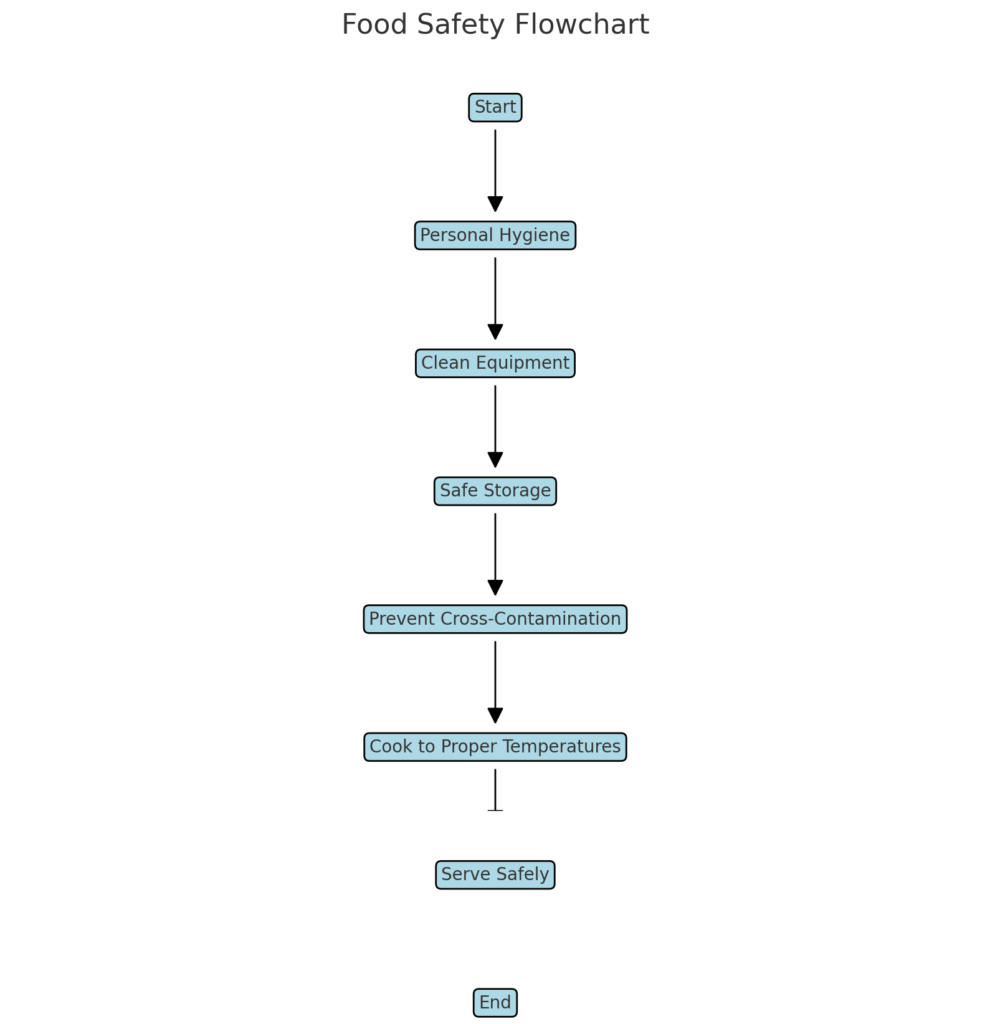Street food is beloved for its flavor, convenience, and cultural richness. However, maintaining food safety standards is crucial to protecting public health and ensuring the success of street food businesses.

This comprehensive guide outlines the 10 Essential Tips for Street Food Vendors to Master Food Safety Standards.
The Importance of Food Safety Standards for Street Vendors
Food safety standards are critical for street food vendors to:
- Protect Customers’ Health: Prevent foodborne illnesses caused by contamination.
- Enhance Business Reputation: Ensure customer trust and repeat business.
- Comply with Regulations: Avoid legal issues by adhering to local health codes.
Common Food Safety Risks for Street Food Vendors
- Cross-contamination from raw ingredients.
- Improper storage of perishable foods.
- Poor personal hygiene practices among handlers.
Essential Tips for Street Food Vendors
1. Personal Hygiene Practices for Food Handlers
Maintaining personal hygiene is the first line of defense against food contamination.
- Wash Hands Frequently: Before handling food, after using the restroom, or touching non-food items.
- Use Clean Uniforms and Gloves: Avoid direct contact with ready-to-eat items.
- Keep Nails Trimmed and Covered: Prevent dirt and bacteria from contaminating food.
| Hygiene Practice | Why It’s Important |
|---|---|
| Wash hands with soap and water | Removes bacteria and viruses |
| Wear hairnets or caps | Prevents hair from falling into food |
| Avoid wearing jewelry | Reduces contamination risks |
2. Maintaining Clean Cooking and Serving Equipment
Cleanliness of tools and equipment plays a significant role in food safety.
- Sanitize Utensils Regularly: Use food-safe disinfectants to clean knives, cutting boards, and serving spoons.
- Keep Surfaces Clean: Wipe down counters and cooking surfaces after every use.
- Store Equipment Properly: Keep utensils in sealed containers to avoid contamination.
3. Proper Storage and Temperature Control
Incorrect storage and temperature can lead to bacterial growth and spoilage.
Guidelines for Safe Food Storage
- Refrigerate Perishable Foods: Keep items like dairy, meat, and seafood below 40°F (4°C).
- Use Airtight Containers: Protect ingredients from pests and environmental contamination.
Importance of Temperature Control
| Food Type | Storage Temperature |
|---|---|
| Raw Meat and Poultry | Below 40°F (4°C) |
| Cooked Foods | Above 140°F (60°C) to prevent bacterial growth |
| Fresh Produce | Store in a cool, dry place |
4. Preventing Cross-Contamination
Cross-contamination occurs when bacteria from one item transfer to another. This is a major food safety hazard.
Preventive Measures
- Separate Raw and Cooked Foods: Use different cutting boards and utensils.
- Label Containers Clearly: Avoid mixing ingredients accidentally.
- Use Color-Coded Tools: Designate specific colors for raw meat, vegetables, and cooked items.
5. Safe Food Handling Practices
Safe food handling is essential to meet food safety standards.
- Thaw Frozen Foods Safely: Thaw in a refrigerator, not at room temperature.
- Cook to Safe Temperatures: Use a food thermometer to ensure meats reach their recommended internal temperatures.
- Serve Food Quickly: Minimize the time food spends in the “danger zone” (40°F to 140°F).
Cooking Temperatures for Common Foods
| Food | Minimum Internal Temperature |
|---|---|
| Poultry | 165°F (74°C) |
| Ground Meats | 160°F (71°C) |
| Seafood | 145°F (63°C) |
6. Waste Management and Pest Control
Proper waste management prevents pests and contamination.
- Dispose of Trash Properly: Use sealed bins and empty them regularly.
- Clean Areas Surrounding the Stall: Keep the vending area free of food scraps.
- Pest Prevention: Seal gaps and use pest-proof containers to store food.
7. Training and Awareness for Street Food Vendors
Education ensures vendors understand the importance of food safety and can implement best practices.
- Attend Food Safety Workshops: Learn local health regulations and food handling practices.
- Distribute Manuals: Provide step-by-step guides for employees.
- Implement Checklists: Use daily food safety checklists to maintain compliance.
Training Focus Areas
- Foodborne illness prevention.
- Recognizing spoiled ingredients.
- Proper cooking and storage techniques.
8. Building Trust Through Food Safety
Customers appreciate visible efforts toward cleanliness and safety.
- Display Hygiene Certificates: Show proof of compliance with food safety regulations.
- Provide Transparent Practices: Let customers see how food is prepared.
- Engage with Customers: Answer questions about food sourcing and preparation practices.
Benefits of Maintaining Food Safety Standards
- Healthier Customers: Reduced risk of foodborne illnesses.
- Better Business: Increased customer satisfaction and loyalty.
- Regulatory Compliance: Avoid fines and legal issues.

Conclusion
Street food vendors play a vital role in providing affordable and delicious meals. By maintaining food safety standards, they not only protect public health but also build trust and grow their businesses.
From proper hygiene practices to safe storage and handling, every step matters in creating a safe and successful street food experience. For more guidance, visit OHSE.ca or check resources like FoodSafety.gov.

No comments yet